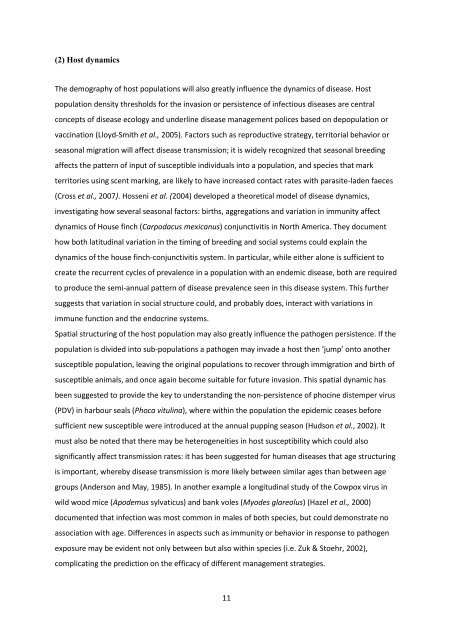Developing an oral bait for badger vaccination - Exeter Research ...
Developing an oral bait for badger vaccination - Exeter Research ...
Developing an oral bait for badger vaccination - Exeter Research ...
Create successful ePaper yourself
Turn your PDF publications into a flip-book with our unique Google optimized e-Paper software.
(2) Host dynamics<br />
The demography of host populations will also greatly influence the dynamics of disease. Host<br />
population density thresholds <strong>for</strong> the invasion or persistence of infectious diseases are central<br />
concepts of disease ecology <strong>an</strong>d underline disease m<strong>an</strong>agement polices based on depopulation or<br />
<strong>vaccination</strong> (Lloyd-Smith et al., 2005). Factors such as reproductive strategy, territorial behavior or<br />
seasonal migration will affect disease tr<strong>an</strong>smission; it is widely recognized that seasonal breeding<br />
affects the pattern of input of susceptible individuals into a population, <strong>an</strong>d species that mark<br />
territories using scent marking, are likely to have increased contact rates with parasite-laden faeces<br />
(Cross et al., 2007). Hosseni et al. (2004) developed a theoretical model of disease dynamics,<br />
investigating how several seasonal factors: births, aggregations <strong>an</strong>d variation in immunity affect<br />
dynamics of House finch (Carpodacus mexic<strong>an</strong>us) conjunctivitis in North America. They document<br />
how both latitudinal variation in the timing of breeding <strong>an</strong>d social systems could explain the<br />
dynamics of the house finch-conjunctivitis system. In particular, while either alone is sufficient to<br />
create the recurrent cycles of prevalence in a population with <strong>an</strong> endemic disease, both are required<br />
to produce the semi-<strong>an</strong>nual pattern of disease prevalence seen in this disease system. This further<br />
suggests that variation in social structure could, <strong>an</strong>d probably does, interact with variations in<br />
immune function <strong>an</strong>d the endocrine systems.<br />
Spatial structuring of the host population may also greatly influence the pathogen persistence. If the<br />
population is divided into sub-populations a pathogen may invade a host then ‘jump’ onto <strong>an</strong>other<br />
susceptible population, leaving the original populations to recover through immigration <strong>an</strong>d birth of<br />
susceptible <strong>an</strong>imals, <strong>an</strong>d once again become suitable <strong>for</strong> future invasion. This spatial dynamic has<br />
been suggested to provide the key to underst<strong>an</strong>ding the non-persistence of phocine distemper virus<br />
(PDV) in harbour seals (Phoca vitulina), where within the population the epidemic ceases be<strong>for</strong>e<br />
sufficient new susceptible were introduced at the <strong>an</strong>nual pupping season (Hudson et al., 2002). It<br />
must also be noted that there may be heterogeneities in host susceptibility which could also<br />
signific<strong>an</strong>tly affect tr<strong>an</strong>smission rates: it has been suggested <strong>for</strong> hum<strong>an</strong> diseases that age structuring<br />
is import<strong>an</strong>t, whereby disease tr<strong>an</strong>smission is more likely between similar ages th<strong>an</strong> between age<br />
groups (Anderson <strong>an</strong>d May, 1985). In <strong>an</strong>other example a longitudinal study of the Cowpox virus in<br />
wild wood mice (Apodemus sylvaticus) <strong>an</strong>d b<strong>an</strong>k voles (Myodes glareolus) (Hazel et al., 2000)<br />
documented that infection was most common in males of both species, but could demonstrate no<br />
association with age. Differences in aspects such as immunity or behavior in response to pathogen<br />
exposure may be evident not only between but also within species (i.e. Zuk & Stoehr, 2002),<br />
complicating the prediction on the efficacy of different m<strong>an</strong>agement strategies.<br />
11
















